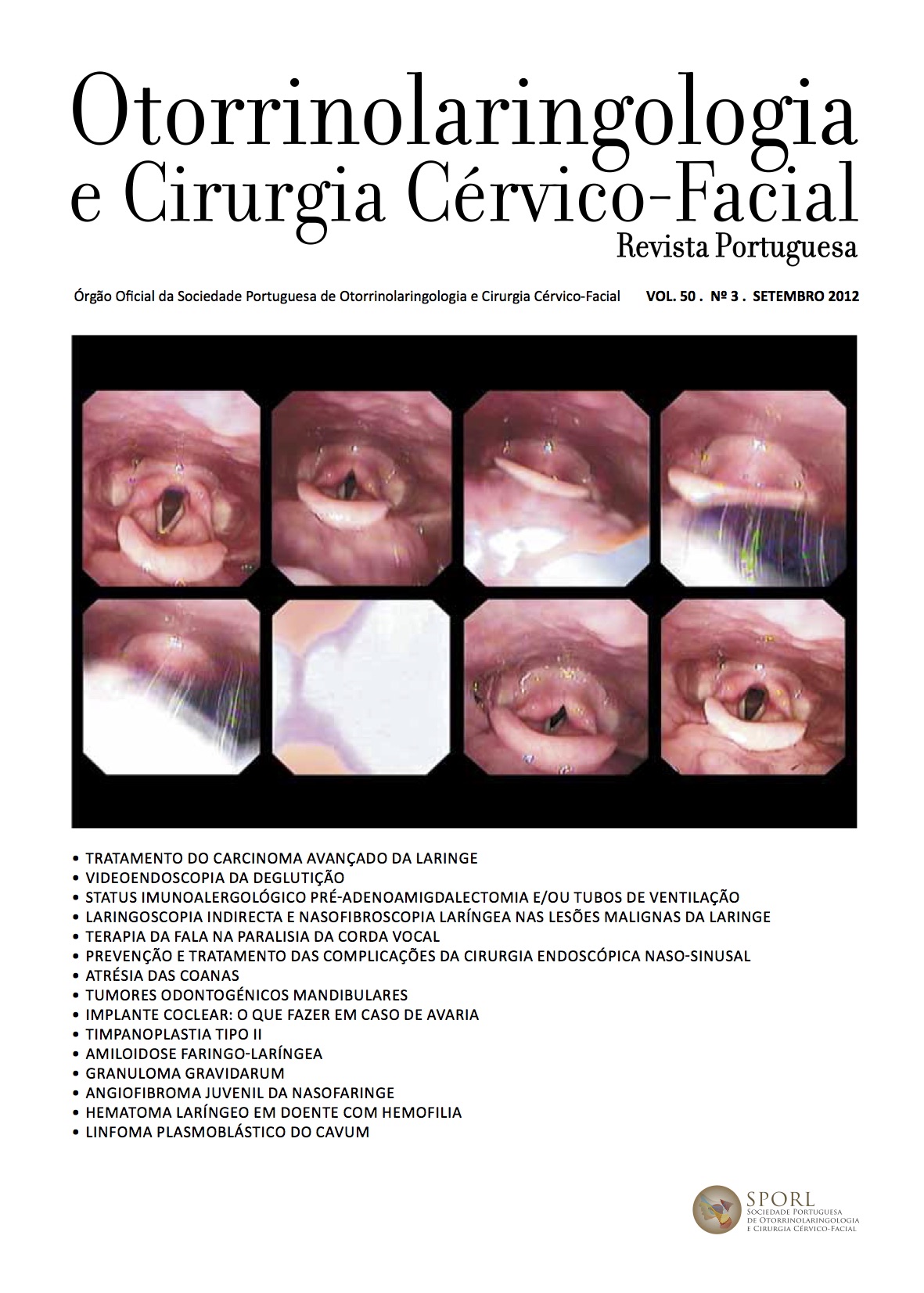Evaluation of the immune allergic status of children that underwent adenotonsillectomy and/or placement of transtympanic ventilation tubes
DOI:
https://doi.org/10.34631/sporl.113Keywords:
sensibilização, alergia, imunologia, infecção, adenoiditeAbstract
Objectives: Evaluate the immune allergic status of children proposed for adenotonsillectomy due to recurrent infections and/or obstructive hypertrophy of the upper airway. To assess the relationship between the allergic status and indication for placement of transtympanic ventilation tubes (TTVT) in children with otitis media with effusion (OME).
Methods: Preoperative assessment of the immune allergic status of 90 children by performing skin prick tests and determination of serum immunoglobulins (Igs). Children were evaluated separately in two groups: group A (children with recurrent infections) and group B (obstructive hypertrophy without infections).
Results: We found a selective deficit of IgA in one child. The serum IgA was significantly lower in group B. 38,9% of children were sensitized to at least one aeroallergen. There was no statistical difference in the prevalence of sensitization among children with and without OME.
Conclusion: Children with obstructive hypertrophy have lower levels of serum IgA. The deficit of Igs is rare and therefore routine screening is not justified. There was no correlation between allergy and OME.
Downloads
References
Marinho AF. Amígdalas e adenóides – da infecção à obstrução. Rev Port Otorrinolaringologia e Cirurgia Cérvico Facial 2010;48:25-32
Suvilehto J, Seppänen M, Notkola IL, et al. Association of allergy, asthma and IgE sensitisation to adenoidectomy and infections in children. Rhinology 200745:286-91
Reichel O, Mayr D, Winterholf J, et al. Tonsillotomy or tonsillectomy? – a prospective study comparing histological and immunological findings in recurrent tonsillitis and tonsillar hyperplasia. Eur Arch Otorhinolaryngol 2007;26:277-284
Amorim AM, Loureiro G, Tomé P, et al. Adenoamigdalectomia e o seu impacto imuno-alergológico – revisão da literatura. Rev Port Imunoalergol 2006;14:91-97
Aghamohammadi A, Moin M, Karimi A, et al. Immunologic evaluation of patients with recurrent ear, nose, and throat infections. Am J Otolaryngol 2008;29:385-392
Tewfik TL, Mazer B. The links between allergy and otitis media with effusion. Curr Opin Otolaryngol Head Neck Surg 2006;14:187-90
Fireman F. Otitis media and eustachian tube dysfunction: Connection to allergic rhinitis. J Allergy Clin Immunol1997;99:787-97
Yeo S, Park D, Eun Y, et al. The role of allergic rhinitis in the development of otitis media with effusion: effect on eustachian tube function. Am J Otolaryngol 2007;28:148-152
Finocchi A, Angelini F, Chini L, et al. Evaluation of the relevance of humoral immunodeficiencies in a pediatric population affected by recurrent infections. Pediatr Allergy Immunol 2002:13:443-447
Surjan L, Brandtzaeg P, Berdal P; Immunoglobulin systems of human tonsils II; Clin Exp Immunol 1978;31:382-390
Brandtzaeg P, Surjan L, Berdal P; Immunoglobulin-producing cells in cliniccaly normal, hyperplastic and inflamed human palatine tonsils; Acta Otolaryngol 1979;360:211-215
Zielnik-Jurkiewicz B, Jurkiewicz D; Implication of immunological abnormalities after adenotonsillectomy. Int J Pediatr Otorhinolaryngol
;64:127-132
Bernstein J, Lee J, Conboy, et al. Further observations on the role of IgEmediated hypersensitivity in recurrent otitis media with effusion. Otolaryngol Head Neck Surg 1985;93:611-5
Marseglia GL, Pagella F, Caimmi D, et al. Increased risk of otitis media with effusion in allergic children presented with adenoiditis. Otolaryngol Head Neck Surg 2008,138:572-5
Nguyen L, Manoukian J, Sobol S, et al. Similar allergic inflammation in the middle ear and upper airway: evidence linking otitis media with effusion to the united airways concept. J Allergy Clin Immunol 2004 Nov;114:1110-5
Marseglia GL, Poddighe D, Caimmi D, et al. Role of adenoids and adenoiditis in children with allergy and otitis media. Curr Allergy Asthma Rep 2009;9:460-4
Modrzynsky M, Zawiska E. Frequency of adenoid hypertrophy in children with allergic diseases. Przegl Lek 2003;60:322-4
Zhang L, Mendoza-Sassi RA, César JA, et al. Intranasal corticosteroids for nasal airway obstruction in children with moderate to severe adenoidal hypertrophy. Cochrane Database Syst Rev 2008;16






